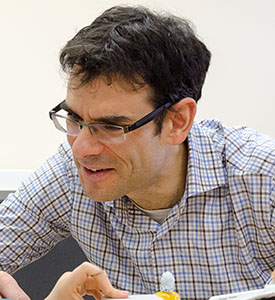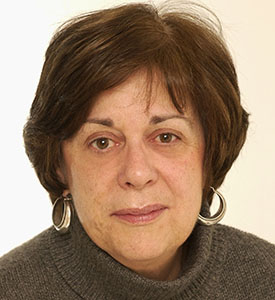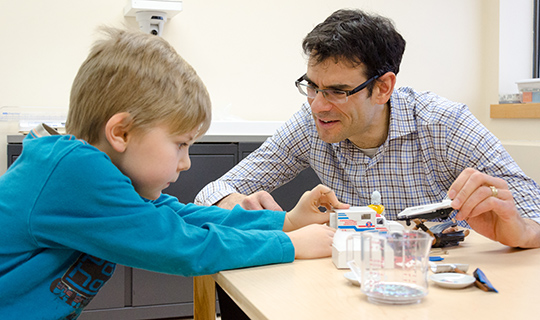Early detection of Autism can mean a lifetime of benefits

Dr. Lonnie Zwaigenbaum
Photo courtesy of Alberta Health Services

Dr. Susan Bryson
Photo courtesy of IWK Health Centre.
CIHR Foundation Grant Recipients
Dr. Susan Bryson
Department of Pediatrics
Faculty of Medicine
Dalhousie University
Dr. Lonnie Zwaigenbaum
Department of Pediatrics
Faculty of Medicine and Dentistry
University of Alberta
Drs. Bryson and Zwaigenbaum – A Dynamic Research Duo
Co-leads of a multi-centre study on Autism Spectrum Disorder (ASD), CIHR-funded researchers Susan Bryson and Lonnie Zwaigenbaum are going the distance, literally and figuratively, to discover new ways to diagnose children with ASD at an early age. Although thousands of kilometres separates these internationally recognized leaders in ASD research, for the past 15 years, they have been working together to explore how to develop and deliver intensive behavioural therapies in infancy to mitigate the symptoms of ASD and improve outcomes.
The first Craig Chair in Autism Research and Professor in the Departments of Pediatrics and Psychology at Dalhousie University and the IWK Health Centre in Halifax, Dr. Susan Bryson, a clinical-developmental psychologist, has focused her research on the early detection of autism and the accompanying benefits of early intervention. With the help of her trainees, she also studies the attention, emotion and the temperaments of children diagnosed with ASD. Dr. Bryson took the lead in developing a province-wide early intervention program for preschoolers with ASD in Nova Scotia, and she has a long-standing interest in and commitment to the well-being of adolescents and adults living with ASD.
Based in Edmonton, Dr. Lonnie Zwaigenbaum, a clinical-developmental pediatrician, is Director of the Autism Research Centre at Glenrose Rehabilitation Hospital – a facility renowned for helping children with developmental disorders to flourish through better understanding, assessment and care.
Dr. Zwaigenbaum has dedicated his career to equipping physicians with more powerful diagnostic and decision-making tools allowing children with autism spectrum disorder to be diagnosed early on so that they and their families can access the support needed to make a meaningful difference.
Supporting advances in improved early detection, diagnosis and treatment of ASD

Photo courtesy of Alberta Health Services.
There is a clear need to increase awareness and create better diagnostic tools. Building on their three previous studies which have cumulatively followed the development of more than 500 children over fourteen years of continuous CIHR funding, Dr. Bryson and Dr. Zwaigenbaum's first published study, released in 2005, is still considered to be foundational a decade later. It resulted in the successful development of their Autism Observation Scale for Infants.
With this new CIHR grant, Drs. Bryson and Zwaigenbaum are setting their sights on a new cohort of children to further their research into ASD detection. Part of the impetus of this new study is to include novel measures and improved resolution of early behavioral signs by using more finely-grained risk assessments.
Together, they are leading the work of a virtual team of eight network researchers, based in various locations across the country.
The investigators with Bryson & Zwaigenbaum's team are focusing on high-risk younger siblings of children diagnosed with ASD. These families experience a rate of recurrence which is much higher than that of the general population. They run almost a 20 % chance of a second child being diagnosed with ASD.
The results of the studies will provide new insight into the early indications of behavioural traits and the tell-tale biomarkers of ASD, allowing them to map the developmental pathways to ASD during infancy.
Affectionately called “The Infant Sibling Project,” the children, with or without ASD, who are participating in this new cohort, will help to answer questions like: Can the way that an infant regulates their emotions and directs their attention indicate risk of autism? Can physiologic measurements (e.g., change in heart rate) tell us about how the infant is experiencing situations that elicit emotional responses? Is it possible to effectively intervene to improve outcomes?
Using computer technology, researchers will gauge a child's ability to shift their attention from one interesting stimulus to another via eye-tracking technology, and assess whether training in this critical skill improves attention control. For instance, understanding what a child looks at, and how flexibly they can move their attention from one interesting object to another may hold important clues about biological vulnerability to ASD. Interpreting this data will help cast light on how the infants process stimuli in their environments.
Assessing the effectiveness of the Social ABCs intervention model, gauging basic early social developmental milestones and parsing the difference in results between genders figures prominently among the team's research goals which they hope to explore more fully in the longitudinal study.
Doctors Bryson and Zwaigenbaum suspect that there may be a number of factors at play and have discovered that some children display classic symptoms of ASD while others display more ambiguous symptoms, making it harder to detect. For instance, girls may develop language and social skills that mask ASD using standard detection methods, especially since most of the tools in use were developed based largely on the behaviour traits of boys.
They will also conduct a mixed-methods study of parents' experiences vis-à-vis an early diagnosis of ASD.
Making a conclusive diagnosis during a relatively brief encounter with a child in a clinical setting is a challenging feat. Hence, the importance of listening to parents, who know their child better than anyone.
However, parents of children with ASD may be in a somewhat unique situation in how they experience the development of their subsequent children. Like many families, they may consider their new infant's development in relation to that of the older sibling. As ASD exists on a spectrum, there may genuinely be differences between the two children even if both are diagnosed with ASD. As a result, some parents may be hesitant to discuss emerging concerns with their younger child, which can impact on the timing of diagnosis. Other aspects of family diversity, including ethnicity, may also influence family preferences related to how concerns are discussed. Drs. Bryson and Zwaigenbaum and their team will evaluate the unique perspective of parents to determine how they prefer to be involved in their child's treatment program.About the Researchers
Susan E. Bryson received her doctorate in Clinical Psychology at McGill University and holds the distinction of being the first recipient of the Joan and Jack Craig Chair in Autism Research. She was an Associate Scientist at the Hospital for Sick Children (HSC) and is the Founding Director of the Autism Research Unit at HSC and the Autism Research Centre at the IWK Health Centre.
Lonnie Zwaigenbaum earned a Doctor of Medicine in 1991, at the University of Toronto and a Masters of Sciences in Health Related Methodology from McMaster University in 2002. He holds cross-appointments at the University of Alberta within the Faculty of Medicine and Dentistry as a Professor of Pediatrics and as an Adjunct Professor, Psychiatry. He also holds the Stollery Children's Hospital Foundation Chair in Autism Research.
- Date modified: